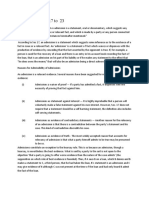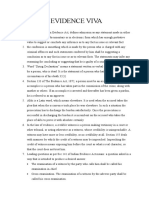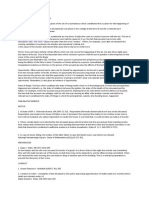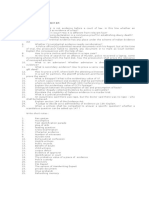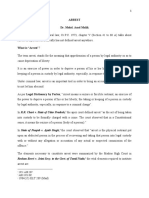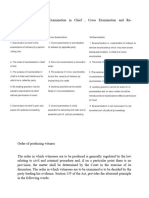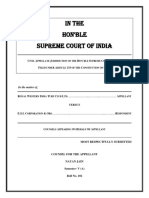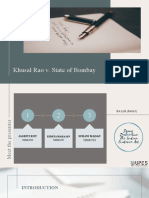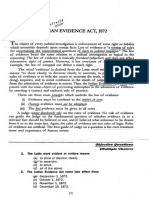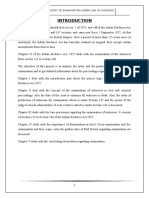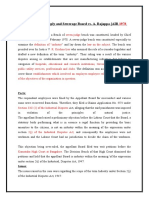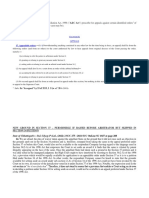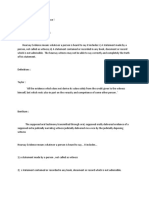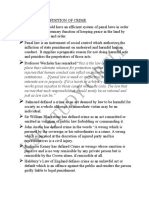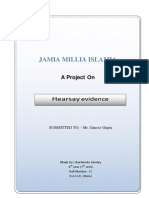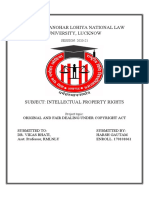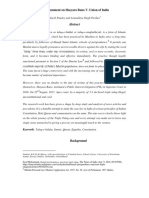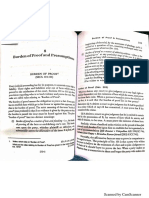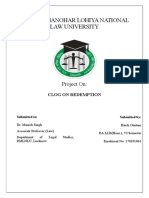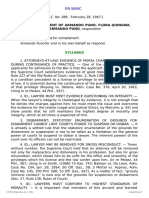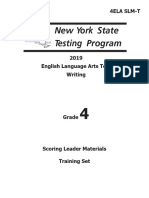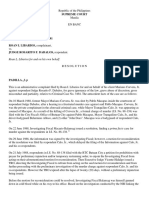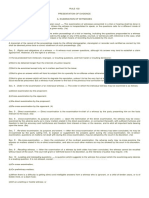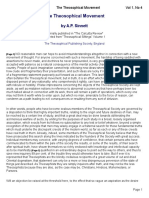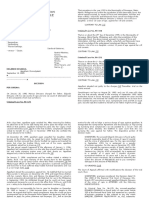DR.
RAM MANOHAR LOHIYA
NATIONAL LAW UNIVERSITY, LUCKNOW
SESSION 2019-20
SUBJECT: LAW OF EVIDENCE
FINAL DRAFT
ON
HEARSAY EVIDENCE
Submitted to: Submitted by:
Dr. Vipul Vinod Harsh Gautam
Assistant Professor (Law) BA.LLB (Hons)5th Sem
Enrollment No.- 170101061
1
� ACKNOWLEDGMENT
I would like to express my gratitude to all those who gave me the possibility to complete this
project. This project is the result of extensive literature study, hard work and labor put in to it
to make it worth reading. I extend my heartily thank to Dr. Vipul Vinod who inspired me to
do this project. I am deeply indebted to him.
I further extend my thanks to library staff of DR. RAM MANOHAR LOHIYA NATIONAL
LAW UNIVERSITY who helped me in getting all the materials necessary for the project.
2
� TABLE OF CONTENTS
HEARSAY EVIDENCE : CONCEPTUAL ANALYSIS ......................................................... 5
Meaning and Definition ......................................................................................................... 5
General Rule Against Hearsay ............................................................................................... 6
History of Rule of Hearsay................................................... Error! Bookmark not defined.
REASONS FOR EXCLUSION OF HEARSAY EVIDENCE .................................................. 8
1. The Irresponsibility of the Original Declarant: .................................................................. 8
2. The depreciation of truth in the process of repetition: ....................................................... 8
3. The opportunities for fraud its admission would open:...................................................... 9
The tendency of such evidence to protract legal enquiries: ................................................... 9
Encourage the substitution of weaker evidence in place of stronger proof: .......................... 9
EXCEPTIONS TO THE GENERAL RULE AGAINST HEARSAY .................................... 11
Res-Gestae and Hearsay Evidence ....................................................................................... 12
Dying Declartion and Hearsay Evidence ............................................................................. 14
3
� INTRODUCTION
Evidence includes everything that is used to determine or demonstrate the truth of
an assertion. Giving or procuring evidence is the process of using those things that are either
(a) presumed to be true, or (b) which were proved by evidence, to demonstrate an assertion’s
truth. Admissible evidence is that which a court receives and considers for the purposes of
deciding a particular case.
In any judicial proceeding, to make any fact admissible before the court of law,
either in the favour of any pre established fact or to establish any fact or in against of any pre
established fact, or to establish any contrary fact, the fact which are to be admissible must be
relevant to become admissible before the court of law. Thus, it is necessary to know which
facts can be taken as relevant facts and which are not. Relevancy of any fact can be ascertained
by bringing it within the purview of Sections 5 to 55 of the Indian Evidence Act, 1872.
Any statement which is an hearsay statement, to be admissible as an evidence, its
relevancy is to be considered. The general principle of common law underlies that an hearsay
statement should not be used in the court of law as this kind of statement are not relevant and
can not be solely relied upon. This principle of common rule is also inherited by the Indian
Law in the Section 60 of Indian Evidence Act, which insists that all oral testimony that is to be
admitted by the court must be direct.
Hearsay evidence can be defined as ‘an assertion other than one made by a person
while giving oral evidence in the proceedings’ which becomes ‘inadmissible as evidence of
any fact asserted’. The admissibility of this kind of Indirect evidence are excluded by the virtue
of Sec 60 of the Indian Evidence Act, but as the history of Hearsay evidence lies to the era of
Common law, its exclusion being one of its major principles, so exception to these principle
are also provided by the common law.
Under Indian Evidence Act too, there are many notable rules which act as an exception to the
general principle of exclusion of Hearsay Evidences. For ex, the law of Res Gestae, law of
4
�Dying Declaration, etc., incorporated in Sec 6 and Sec 32 of the Act perform as hearsay
evidence and are taken to be relevant and thus are admissible before the court.
HEARSAY EVIDENCE : CONCEPTUAL ANALYSIS
Hearsay refers to testimony given in court by a person other than the one who
perceived it. It is only the reported evidence of a witness which he has nor seen neither heard.
Sometime it implies the saying of something which a person has heard others say. It is defined
as ‘An assertion other than one made by a witness while testifying in the proceedings is
inadmissible as evidence of any fact asserted’1. Another definition set out in Murphy2 is that,
“Hearsay is a statement other than one made by the declarant while testifying at the trial or
hearing, offered in evidence to prove the truth of the matter asserted.”
Meaning and Definition
The word ‘hearsay’ is used in various senses. Sometimes it means whatever a
person is heard to say; sometimes it means whatever a person declares on information given by
someone else – Stephen. Hearsay evidence, which is called as derivative, second hand, and
unoriginal evidence, etc., is the evidence of facts, which the witness has not learnt through his
own bodily senses but learnt through the medium of anothers. The term “hearsay” was regarded
by the writers as ambiguous and misleading as it is used in more than one senses. Stephen says,
“Sometimes it means whatever a person is heard to say; sometimes it means whatever a person
declared on information given by someone else; sometimes it is treated as merely synonymous
with irrelevant.3 Taylor defines hearsay evidence to denote,
“all the evidence which does not derive its value solely from the credit given to the witness
himself, but which rests also in part on the veracity and competence of some other person.”4
From the various definitions quoted above it is clear that the term ‘hearsay’ is
used with reference to that which is written as well as that which is spoken, and, in its legal
sense, it denotes that kind of evidence which does not derive its value solely from the credit to
1
Heydon, J.D. & Cross, R, 2004, Cross on Evidence, 7th edition, LexisNexis Butterworths Sydney, ch 16.
2
Definition given by Murphy in American Federal Rule on Evidence 801.
3
Stephen’s Digest of Law of Evidence.
4
Taylor’s Evidence, P. 570.
5
�be given to the witness himself, but rests also in part on the competency of some other person.
For example, when the witness says that he himself did not hear the defamatory words but
another person told him about it, the credit for hearing the statement does not go to the witness
but to somebody else. Similarly, when the witness says that he did not see the occurrence
himself but somebody told him the credit of seeing the occurrence does not go to witness but
it goes to somebody else.
General Rule Against Hearsay
As a general rule hearsay is inadmissible. And this draws from section 60 of the
Evidence Act, which explicitly provides that oral evidence must be direct. The rule against
hearsay is stated as follows:
“A statement made by a person not called as a witness which is offered in
evidence to prove the truth of the fact contained in the statement is hearsay and it is not
admissible. If however the statement is offered in evidence, not to prove the truth of the
facts contained in the statement but only to prove that the statement was in fact made it
is not hearsay and it is admissible” - Justice De Silva.
In Lim Yam Yong v. Lam Choon & Co., The Hon’ble Bombay High Court
adjudged “Hearsay Evidence which ought to have been rejected as irrelevant does not become
admissible as against a party merely because his council fails to take objection when the
evidence is tendered.” So finally, we can assert that Hearsay Evidence is that evidence which
the witness has neither personally seen or heard, nor has he perceived through his senses and
has come to know about it through some third person. When a piece of evidence is such that
there is no prima facie assurance of its credibility, it would be most dangerous to act upon it.
Hearsay evidence being evidence of that type has therefore, to be excluded whether or not the
case in which its use comes in for question is governed by the Evidence Act.
The evidence of a statement made to a person who himself is not called as a
witness may or may not be hearsay. It is ‘hearsay’ and inadmissible when the object of evidence
to establish the truth of what is contend in the statement by examining some other person. It is
not ‘hearsay’ and it is admissible when it is proposed to established by the evidence, not the
truth of the statement but the fact that the statement was made. The fact that the statement was
6
�made is quite different from the fact that the statement was made. The fact that statement was
made, apart from its truth, is frequently relevant in considering the mental state and conduct
thereafter of the witness or some other person in whose presence the statement was made.
In the case, J. D. Jain v. Management v. State Bank of India4, the accused was a
cashier in the state bank of India. One Kaushal withdrew Rs. 500 from his saving bank account.
When he came to take back his passbook he noticed that Rs. 1500 have been debited from his
account. He orally complained in presence of many person that he submitted a withdrawal form
of Rs. 500 only to the accused and not of Rs. 1500. In Inquiry the accused confessed that he
had made Rs. 1500 for Rs. 500, the entries were found to be altered. The fact that person had
made on oral complaint that Rs. 1000 were wrongly debited to his account was proved by other
evidence as Kaushal was not examined. It was held that the evidence was not hit by the rule of
‘hearsay’.
In Kashi Nath v. Emperor5, the accused was tried for the rape committed on a
child of three and half years. The evidence of the Father, mother and sister to whom the child
complained was sought to be proved against the accused, since the child was not produced as
a witness, she being not competent. The evidence of the statements and conduct by the child
given by the father, mother and sister was held to be inadmissible on the ground of Hearsay. If
the object of the evidence is to prove the truth of the hearsay statements, it is inadmissible, but
if it is intended to prove the fact that such a statement was made, it is admissible.
In another case, where the statement of prosecution witness No. 5 was that the
wife of the deceased has disclosed that her husband has been assaulted by the accused cannot
be relied upon, since the wife of the deceased died before she was examined, and as such
statement amounts to hearsay evidence.6
Thus, from these case laws, it is clear that hearsay evidences are excluded from
being admitted in a case as a general rule of common law which is followed in India. The
reasons for its exclusion are dealt further in this project work. It is pertinent to mention here
4
AIR 1982 SC 673.
5
AIR 1942 Cal. 214.
6
Nanuram v. State, 2005 Cr. LJ 4586 (MP).
7
�that this general rule of exclusion of Hearsay evidence is nowhere mentioned and is entirely
based on the historical view related to this.
REASONS FOR EXCLUSION OF HEARSAY EVIDENCE
The hearsay evidence is discarded on the basis of its relative untrustworthiness
for judicial purpose on account of:
1. The Irresponsibility of the Original Declarant:
The principle of this rule is, that such evidence requires credit to be given to
statement made by person who is not subjected to ordinary test enjoined by the law for
ascertaining the correctness and completeness of his testimony, namely, that oral testimony
should be delivered in the presence of the court or a magistrate, under the moral and legal
sanctions of an oath, and where the moral and intellectual character, the motive and the
demeanour of the witness can be examined, and his capacity and opportunity for observation,
and his memory, can be tested by cross-examination. Such evidence, moreover as to oral
declarations is very legible to be fallacious and its value is therefore greatly lessened by the
probability that the declaration was imperfectly heard, or was misunderstood, or is not
accurately remembered or has been perverted. Wigmore is of the view that it is the fact that the
adverse party has had no opportunity to cross-examine the maker of an extra-judicial statement
that is the real basis of the exclusion of hearsay.
Every witness is required by law to depose evidence under personal
responsibility. In case of irect evidence the penal provisions for perjury will have a detterent
effect on the witness and makes him to speak truth. But, in this, the person communicating such
evidence are not exposed to the danger of a prosecution for perjury, in which something more
that the testimony of one witness is necessary, in order to result in conviction.
2. The depreciation of truth in the process of repetition:
When someone reports a fact to someone else and that someone else testifies
about the fact in court, the passing of the information through an extra person creates a greater
possibility of distortion. This distortion may be intentional or inadvertent. Also, in the process
8
�of repetition of the statement of the original declarant, there is every likelihood of omissions
and commissions of the facts. These errors of omissions and commissions result in the
depreciation of the truth of the facts and likely to prejudice the legal proceedings.
3. The opportunities for fraud its admission would open:
Admissions of hearsay evidence would open the way for playing fraud by the
witness, since the original declarant who is the source of information is not available to give
evidence.
The tendency of such evidence to protract legal enquiries:
Public policy demands that justice must be expeditious. By allowing hearsay
evidence the court may have to waste its time in listening to the idle gossip and thereby the
legal proceedings are unduly protracted.
The greatly increased expense and the vexation which the adverse party must
incur in order to rebut or explain it, the vast consumption of public time, thereby occasioned,
the multiplication of the collateral issue for decision by the jury and, the danger of losing sight
of the main question and of the justice of the case if this sort of proof were admitted, are
consideration of too grave a character to be overlooked by the court or the legislature, while
deciding whether the Hearsay evidence can be included as a valid evidence against accused or
not.
Encourage the substitution of weaker evidence in place of stronger proof:
When the best evidence rule requires all oral evidence to be direct, any admission
of hearsay evidence encourages for the substitution of weaker evidence in the of stronger proof
The Rule of Best Evidence is a cardinal rule in the law of evidence which says
that the best available evidence should be brought before the court. The provisions of sections
60, 64 and 91 are based on this rule. As per section 60, oral evidences must be direct, that is to
say if the fact to be proved is a fact which can be seen or which can be heard, it must be proved
by the evidence of a witness who says that he saw it, or he himself heard it, etc. Section 64 lays
down that documents must be proved by the primary evidence except where secondary
9
�evidence is allowed by the Act. Section 9 lays down that when the terms of a contract, grant or
any other disposition of property have been reduced to the form of writing, no proof of them
can be given except the document itself, except the secondary evidence when it was permissible
by law.
The Apex Court in Kalyan Kumar Gogoi V Ashutosh Agnihotri, had provided
reasons why hearsay evidence is not received as relevant evidence are:
1. The person giving such evidence does not feel any responsibility. The law requires all
evidence to be given under personal responsibility. i.e., every witness must give his
testimony, under such circumstances, as expose him to all the penalties of false hood.
2. Truth is diluted and diminished with each repetition, and
3. If permitted, gives ample scope for playing fraud by saying “someone told me that...”
4. It would be attaching importance to false rumor flying from one foul lip to another.
Thus, statement of witnesses based on information received from others is inadmissible.
10
� EXCEPTIONS TO THE GENERAL RULE AGAINST HEARSAY
A number of exceptions have been recognized to facilitate for the admission of
hearsay evidence. These exceptions have been imported into the Indian Evidence Act as a
rule of necessity. The following are the exceptions to the rule that hearsay evidence is no
evidence.
1. Res Gestae – statements made by persons who are not examined may be proved
through other persons who appear as witness and they amount to ‘original’ as
distinguished from ‘hearsay’ or derivative evidence, provided such statements form
part of the transaction in issue.
2. Admissions and Confessions – an extra judicial admission or a confession which is
sought to be proved through the testimony of a witness to whom such admission or
confession is made, is admissible as an exception.
3. Statements under Section 32 – statements made by the persons who cannot be called
as a witness because they are either dead, or cannot be found, or have become
incapable of giving evidence or their attendance cannot be procured without an
amount of unreasonable expense or delay in the opinion of the court, are admissible
as an exception to the hearsay rule.
4. Evidence given in the former proceedings – under section 33, a evidence given by a
witness in a formal judicial proceeding or before any person authorized by law to take
it, is relevant to prove the truth of the facts which it states in any subsequent judicial
proceeding or in later stage of the same judicial proceeding, provided the witness is
dead, etc. this is an exception to hearsay rule.
5. Statements in Public Documents – statements contained in public documents, such as
official or public books, registers or records, the Act of Parliament, foreign law
contained in book etc., can be proved by the production of the respective documents
and there is no necessity of producing the person who drafted these public documents.
But recital as to the contents of Public Documents would only amount to purely
hearsay evidence and not admissible in evidence unless the documents are produced
11
� before the court. In a prosecution for murder, recital made in a map prepared by the police
indicating the place where the deceased is alleged to have been assaulted by the accused
person was held to be hearsay evidence and therefore cannot be read as evidence.7
6. Proviso I, Section 60 – this proviso to the general rule contained in the main section
is analogous to the exceptions made in section 32 of the Act must be read with Section
45 of the Act.
Proviso I declares that the opinions of experts expressed in any treatise commonly
offered for sale and the grounds on which such opinion are held can be proved by the
production of such treatise without calling that expert, provided the author is not available
as witness for the reasons analogous to section 32.
7. Proviso II to Section 60 – according to the second proviso, the court may require the
production of any material thing for its inspection, if the oral evidence refers to the
existence of that material thing. Under section 165 of the Evidence Act a judge may
in order to discover or obtain proper proof of relevant facts, direct for the production
of any document or thing.
All these are exceptions to the general rule of exclusion of hearsay evidence to be
used as a valid evidence. Different legal systems have different sets of exceptions to the
common law rule against hearsay evidence. But every legal system essentially recognises some
of the basic exceptions like Res Gestae, Dying Declaration, etc. some of these exceptions are
elaborated here:
Res-Gestae and Hearsay Evidence
The res gestae exception provides that a statement is admissible if it accompanies
and explains an act. The justification given for the reception of such evidence is the light that
it shines upon the act or event in issue. In its absence, the transaction in question may not be
fully or truly understood and may even appear meaningless. 8 If the court were to dismiss
Evidence which is so clearly relevant to the case, it would lead to substantial injustice that
7
Girish Yadav v. State of M.P., 1996 CrLJ 2159 (SC).
8
Adrian Keane, ‘Modern Law of Evidence’ 8thed. Oxford at 350.
12
�would undermine the primary function of the legal system. On its merits, the res gestae
exception gives discretion to Judges to decide whether such Evidence shall be admitted. The
fact that each case can be decided on a subjective basis is something which should be
commended.
In reference to case law, R v. Andrews, was an important English decision on the
res gestae principle. It showed a more liberal approach by the courts to the admissibility of
hearsay Evidence.9. In Andrew’s case two men entered M’s flat and attacked him with knives
and property was stolen. Two police officers arrived shortly after and M informed them that O
and the defendant were responsible. M. died two months later as a result of his injuries. The
defendant and O were charged with aggravated burglary and the murder of M.
The deceased’s statement was admitted as coming within the res gestae exception. In coming
to his decision, Lord Ackner established and applied a five stage objective test for the admission
of such evidence.
The five stage test is as follows; (1) Can the possibility of concoction or distortion
be disregarded. (2) If the event was so unusual or dramatic that it dominated the thoughts of
the victim causing an instinctive reaction without the possibility of fabrication, in conditions
of approximate but not exact contemporaneity. (3) To be sufficiently spontaneous that
statement must be closely connected with the event causing it. (4) There must be no special
features making concoction or distortion likely. (5) There must be no special features likely to
result in error. e.g. Intoxication.16
Section 6 of the Evidence Act is an exception to the aforesaid hearsay rule and
admits of certain carefully safeguarded and limited exceptions and makes the statement
admissible when such statements are proved to form a part of the res gestae, to form a particular
statement as a part of the same transaction or with the incident or soon thereafter, so as to make
9
R.A Clark: Changing face of the rule against hearsay in English law, Akron law review 1987-1988 at 71
16
R v. Andrews [1987] A.C. 281.
13
�it reasonably certain that the speaker is still under stress of excitement in respect of the
transaction in question.10
The Supreme Court in Gentela Vijavavardhan Rao v. State of Andhra Pradesh18,
considering the law embodied in section 6 of the Evidence Act held thus:
"The principle of law embodied in section 6 of the Evidence Act is usually known
as the rule of res gestae recognized in English law. The essence of the doctrine is that a fact,
which, though not in issue, is so connected with the fact in issue "as to form part of the same
transaction" becomes relevant by itself. This rule is roughly speaking an exception to the
general rule that Hearsay Evidence is not admissible. The rationale in making certain
statement or fact admissible under section 6 of the Evidence Act is on account of the
spontaneity and immediacy of such statement or fact in relation to the fact in issue. But it is
necessary that such fact or statement must be a part of the same transaction. In other words,
such statement must have been made contemporaneous with the acts, which constitute the
offence, or at least immediately thereafter. But if there was an interval, however slight it may
be, which was sufficient enough for fabrication then the statement is not part of res gestae."
Dying Declaration and Hearsay Evidence
A dying declaration is a statement made by a dying person as to the cause of his
death or as to any circumstances of the transaction that resulted in his death. It is evidence under
Section 32(1) of Indian Evidence Act,1872. This section is an exception to the general rule that
hearsay evidence is no evidence.
The dying declaration is a statement by a person as to the cause of his death or as
to any of the circumstances of the transaction which resulted in his death and it becomes
relevant under section 32(1) of the Evidence Act in a case in which the cause of that person's
death comes into question. It is true that a dying declaration is not a deposition in Court and it
is neither made on oath nor in the presence of the accused. It is, therefore, not tested by cross
examination by way of an exception to the general rule against the admissibility of Hearsay
10
Vasa Chandrasekhar Rao. Ponna Satyanarayana, AIR 2000 SC 2138:(2000) 6 SCC 286: 2000 Cr LJ 3175. 18
,(1996) 6 SCC 241.
14
�Evidence on the principal of necessity. The Supreme Court held that in the present case the
statement of the prosecutrix does not directly state any fact regarding the cause of her death
and at the most it could be stretched to say referring to the circumstances of the transaction
resulting in her death.11
The Supreme Court observed that a dying declaration made by a person who is
dead as to the cause of his death or as to any of the circumstances of the transaction which
resulted in his death, in cases in which the cause of his death comes in question is relevant
under section 32 of the Evidence Act and is admissible in evidence. Though dying declaration
is indirect evidence being a piece of hearsay, yet it is an exception to the rule against
admissibility of Hearsay Evidence. Indeed it is substantive evidence and like any other
substantive evidence requires no corroboration for forming basis of conviction of an accused.
But then the question as to how much weight can be attached to dying declaration is question
of fact and has to be determined on the facts of each case. In the instant case there is
circumstantial evidence which corroborates the dying declaration viz. The statement of the
witnesses that they found the victim in her room where the smell of kerosene was present, the
statement of the doctor who conducted the post mortem after four days of the accident that he
noticed the smell of kerosene from the scalp of the deceased, the statement of witnesses stating
that the appellant delayed the opening of lock on one pretext or the other and the statement of
the appellant that she died of an accident while igniting, the oven and that he had put water on
her was belied from the evidence on record as no sign of water was found in the kitchen and
that the ash in the oven was found intact. These facts the court observed lend assurance to the
truth of the declaration of the deceased.12
CONCLUSION
Hearsay is information gathered by one person from another person concerning
some event, condition, or thing of which the first person had no direct experience. When
submitted as evidence, such statements are called hearsay evidence. Oral or written testimony
about an out-of-court statement attributed to someone other than the testifying person is said to
be the hearsay evidence. Such evidence is generally inadmissible because the person to whom
11
Tapinder Singh v. State of Punjab, (1971) 1 SCJ 751.
12
Ram Bihari Yadav v. State of Bihar, AIR 1998 SC 1850: (1998) 4 SCC 517.
15
�the statement is attributed cannot be cross-examined to ascertain its factual basis. This is the
general rule of non-admissibility of hearsay evidence in court as to either prove or disprove any
fact.
The reason behind non admissibility is that the rule against hearsay has its basis
in the principle of orality according to which truth is best ascertained by the unrehearsed
answers on oath or affirmation of witnesses who have perceived the relevant events and who
are then subjected to cross-examination in the presence of the courts. A hearsay statement is
by definition not made before the court and, if the maker does not testify, he cannot be cross-
examined nor can his demeanour be observed or his credibility tested. Where the hearsay
statement narrated is oral, there is a chance that it may be altered in the telling. Where it is
made formally there is the danger that it will be tailored to the requirements of the party making
it. A further reason sometimes given for the rule against hearsay is the possibility that a jury,
where there is one, will be confused by a proliferation of evidence of little value.
The hearsay rule has been part of the common law justice system for several
centuries. In its pure common law form is a far reaching rule with a severe constraining effect
on what evidence is admissible. The common law has developed some exceptions to the rule
against hearsay. These exceptions have become insufficient for the administration of justice in
the modernizing world. There have been many statutory exceptions which have further eroded
the rule against hearsay evidence.
Under Indian Evidence Act, there are many recognized exceptions of the general
rule against Hearsay evidence. The major ones are Rules of Res Gestae underlined under Sec
6 of the Act and the rules of Dying Declaration underlined under Sec 32 of the Act.
16
�BIBLIOGRAPHY
Referred Sites:
• http://www.legalblog.in/2011/01/hearsay-evidence-law.html
• http://www.ockadvocates.com/2013/02/admissibility-of-hearsay-evidence-and-ruleagainst-
hearsay/
• http://www.legalindia.in/different-kinds-of-evidences-witnesses-under-the-indian-
evidenceact
• http://www.lawteacher.net/common-law/essays/admissibility-of-evidence-recorded-
lawessays.php
Referred Books
• Ratanlal & Dhirajlal, The Law of Evidence, 23rd enlarged edition, Reprint 2011, Lexis Nexis
Butterworths Wadhwa, Nagpur.
• Lal, Batuk, Law of Evidence, 19th Edition, 2013, Central Law Agency, Allahabad.
17
